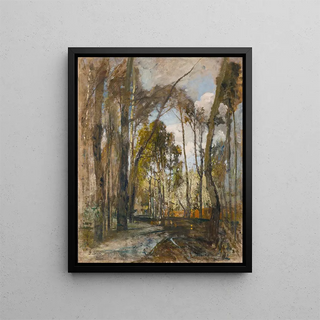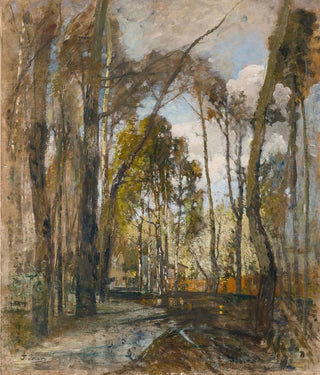Art print | The Gardens of Prater after the Rain - Tina Blau


View from behind

Frame (optional)
In the vast panorama of art history, certain works stand out for their ability to capture the essence of fleeting moments and immortalize the ephemeral beauty of nature. "Les jardins du Prater après la pluie" by Tina Blau perfectly embodies this tradition. This canvas, both delicate and vibrant, transports us to the heart of a Viennese garden, where raindrops shimmer on the leaves and light plays with colors. The artist, a true virtuoso, succeeds in evoking an atmosphere of serenity and contemplation, inviting the viewer to immerse themselves in this enchanting landscape. Through this artwork, Blau reminds us that beauty is often found in the simplest, yet most fleeting, details.
Style and uniqueness of the artwork
Tina Blau's style is characterized by an impressionist approach that flourishes in the bold use of color and light. In "Les jardins du Prater après la pluie," shades of green and blue blend harmoniously, creating a lively scene where each brushstroke seems to capture a precise moment. The rain, omnipresent, almost becomes a character in its own right, adding a sense of freshness and renewal to the scene. The artist excels in depicting nature, but what makes this work so unique is its ability to evoke deep emotions through familiar landscapes. The viewer is not only a witness to a moment but also an active participant in this sensory experience, feeling the coolness of the air and the scent of flowers after the shower.
The artist and her influence
Tina Blau, a prominent figure in 19th-century Austrian art, managed to establish herself in a field often dominated by male artists. Her artistic journey is marked by a desire to represent nature with rare authenticity, a quest that led her to explore various landscapes across Europe. Influenced by the great masters of Impressionism, she developed a personal style that combines technical rigor with sensitivity. Her work paved the way for many female artists, inspiring generations of women painters to assert themselves.

Matte finish

View from behind

Frame (optional)
In the vast panorama of art history, certain works stand out for their ability to capture the essence of fleeting moments and immortalize the ephemeral beauty of nature. "Les jardins du Prater après la pluie" by Tina Blau perfectly embodies this tradition. This canvas, both delicate and vibrant, transports us to the heart of a Viennese garden, where raindrops shimmer on the leaves and light plays with colors. The artist, a true virtuoso, succeeds in evoking an atmosphere of serenity and contemplation, inviting the viewer to immerse themselves in this enchanting landscape. Through this artwork, Blau reminds us that beauty is often found in the simplest, yet most fleeting, details.
Style and uniqueness of the artwork
Tina Blau's style is characterized by an impressionist approach that flourishes in the bold use of color and light. In "Les jardins du Prater après la pluie," shades of green and blue blend harmoniously, creating a lively scene where each brushstroke seems to capture a precise moment. The rain, omnipresent, almost becomes a character in its own right, adding a sense of freshness and renewal to the scene. The artist excels in depicting nature, but what makes this work so unique is its ability to evoke deep emotions through familiar landscapes. The viewer is not only a witness to a moment but also an active participant in this sensory experience, feeling the coolness of the air and the scent of flowers after the shower.
The artist and her influence
Tina Blau, a prominent figure in 19th-century Austrian art, managed to establish herself in a field often dominated by male artists. Her artistic journey is marked by a desire to represent nature with rare authenticity, a quest that led her to explore various landscapes across Europe. Influenced by the great masters of Impressionism, she developed a personal style that combines technical rigor with sensitivity. Her work paved the way for many female artists, inspiring generations of women painters to assert themselves.






